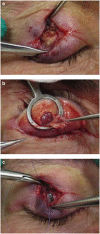The clinical, histological and immunohistochemical characteristics and nomenclature of meibomian gland ductal cysts (intratarsal keratinous cysts) and eyelid steatocystomas
- PMID: 28085143
- PMCID: PMC5437325
- DOI: 10.1038/eye.2016.313
The clinical, histological and immunohistochemical characteristics and nomenclature of meibomian gland ductal cysts (intratarsal keratinous cysts) and eyelid steatocystomas
Abstract
PurposeMeibomian gland ductal cysts (MGDCs) and steatocystomas are epithelial lined, keratin-containing lesions of the eyelids. MDGCs are variably called tarsal keratinous cysts, intratarsal keratinous cysts of the meibomian glands, intratarsal inclusion cysts, epidermal cysts and epidermoid cysts. Both lesions are poorly described in the literature. We report a series of seven MGDC and steatocystomas, and examine their clinical, pathological and immunohistochemistry features and their management and outcomes.Patients and methodsA retrospective review of case notes and histopathology slides of all MGDCs and steatocystomas identified at one major histopathology service in South Australia between 2013 and 2015.ResultsSeven cases were identified, with an average age of 64. The lesions range from 4 to 18 mm diameter and are firm, well-circumscribed and non-tender, and sometimes the keratin-filled cyst protrudes visibly under the tarsal conjunctiva. Two cases were previously misdiagnosed as chalazia but recurred after incision and curettage. Histologically, these lesions are lined by squamous epithelium but lack a well-formed stratum granulosum and can be distinguished by their immunohistochemical staining characteristics. Complete excision, including a wedge of underlying tarsal plate for MDGCs, is curative for with a follow up of 12-36 months.ConclusionsMGDCs and steatocystomas should be included in the differential of benign eyelid lesions. Diagnosing and differentiating these lesions from chalazia is important for determining the optimal management strategy.
Conflict of interest statement
The authors declare no conflict of interest.
Figures


References
-
- Jakobiec FA, Mehta M, Iwamoto M, Hatton MP, Thakker M, Fay A. Intratarsal keratinous cysts of the Meibomian gland: distinctive clinicopathologic and immunohistochemical features in 6 cases. Am J Ophthalmol 2010; 149(1): 82–94. - PubMed
-
- Lucarelli MJ, Ahn HB, Kulkarni AD, Kahana A. Intratarsal epidermal inclusion cyst. Ophthal Plast Reconstr Surg 2008; 24(5): 357–359. - PubMed
-
- Vagefi MR, Lin CC, McCann JD, Anderson RL. Epidermoid cyst of the upper eyelid tarsal plate. Ophthal Plast Reconstr Surg 2008; 24(4): 323–324. - PubMed
MeSH terms
Substances
LinkOut - more resources
Full Text Sources
Other Literature Sources
Medical

